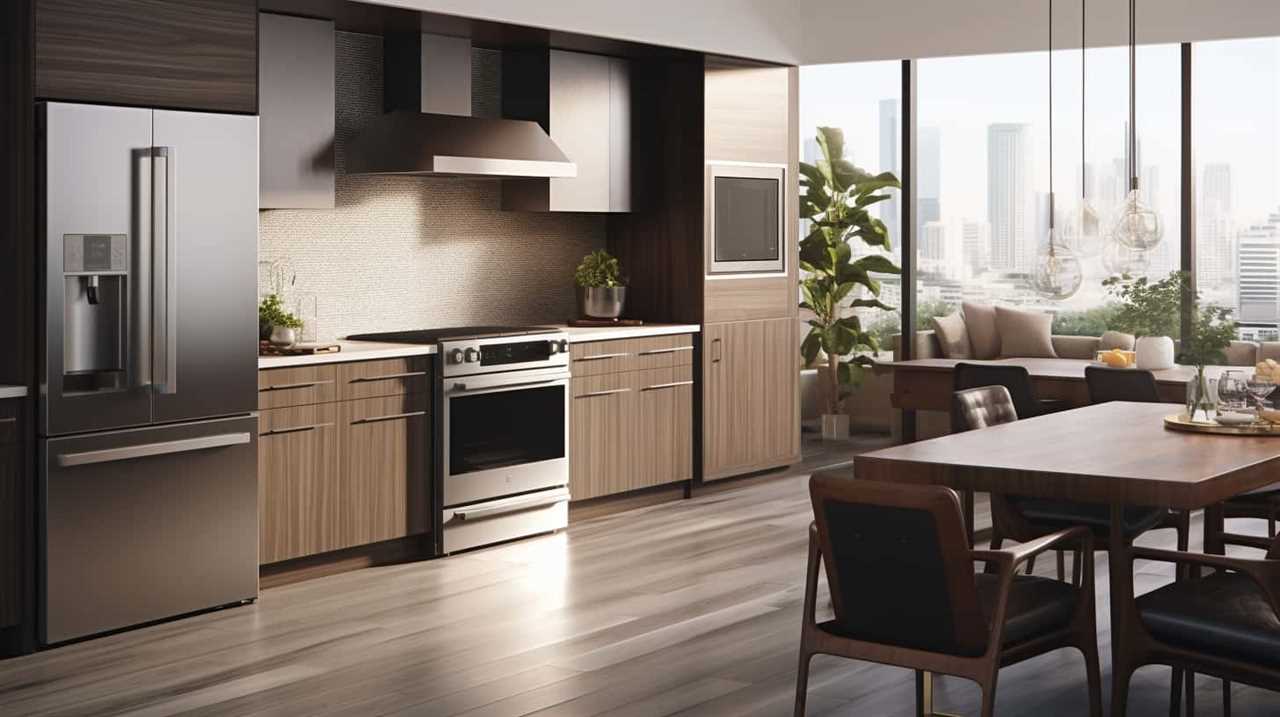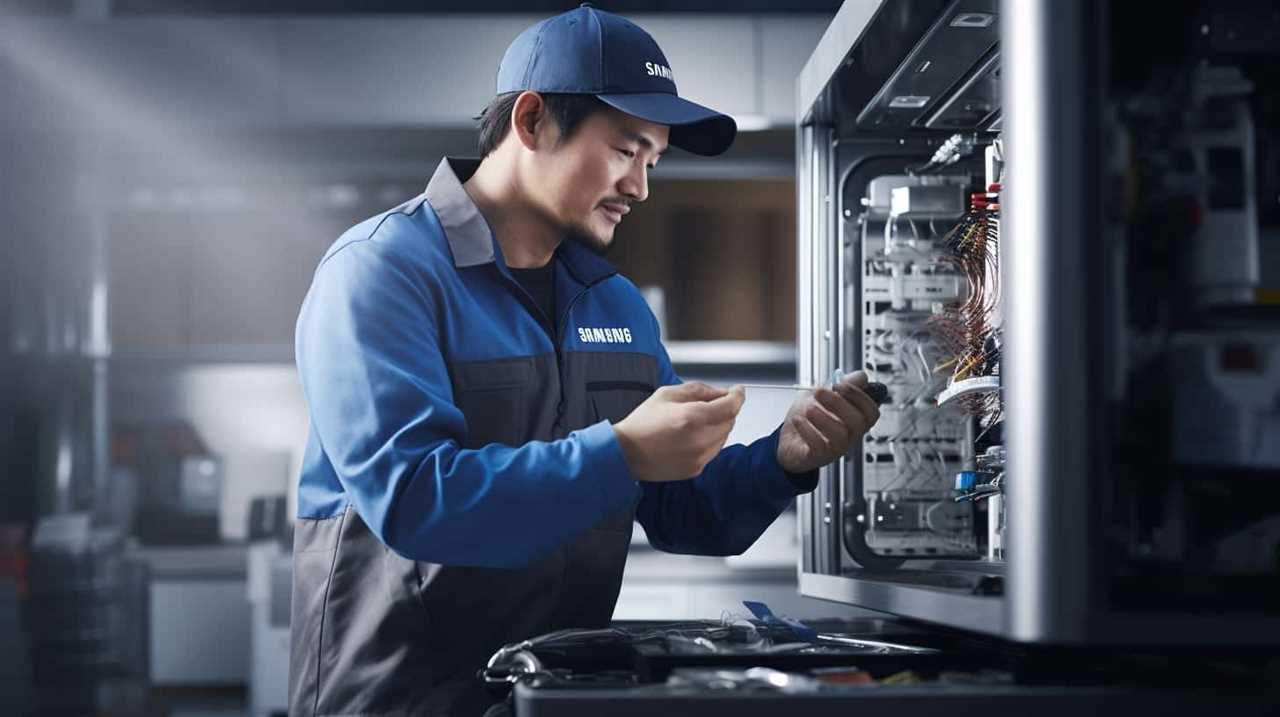Wondering if your US appliances will work in the UK? Don’t worry, we have all the information you need.
In this article, we’ll delve into the world of voltage differences, plug types, and the use of adapters and converters. We’ll also explore the difference between voltage converters and transformers, as well as provide tips for buying appliances in the UK.
So, let’s get started on this electrifying journey!
Key Takeaways
- US appliances operate on 120 volts, while UK appliances operate on 230 volts.
- Plug adapters can be used to fit US appliances into UK outlets.
- US appliances with Type A plugs require adapters for UK outlets.
- Voltage converters or transformers may be necessary to adjust the voltage for US appliances in the UK.
Voltage Differences
One major difference between US and UK appliances is the voltage. In the United States, appliances typically operate on a voltage of 120 volts, whereas in the United Kingdom, the standard voltage is 230 volts.

This discrepancy in voltage can pose a challenge when using US appliances in the UK. To address this issue, plug adapters can be used to convert the shape of the plug and allow it to fit into UK outlets. However, it’s important to note that plug adapters don’t convert the voltage itself.
Therefore, it’s crucial to ensure that the US appliance is compatible with the higher voltage before using a plug adapter. Failing to do so could result in damage to the appliance and potential electrical safety hazards.
Plug Types
To continue our discussion on the differences between US and UK appliances, let’s now explore the various plug types used in these two countries.
The types of plugs used in the US and UK differ significantly, making plug compatibility an important consideration when using appliances across countries.

In the US, the most common plug type is the Type A plug, which has two flat pins. The UK, on the other hand, uses Type G plugs, which have three rectangular pins.
These differences mean that US appliances with Type A plugs won’t fit into UK outlets without an adapter.
It’s crucial to check the plug type of your appliance and ensure it’s compatible with the outlets in the country you plan to use it in.
Adapters and Converters
Now let’s talk about adapters and converters, which are essential for using US appliances in the UK.
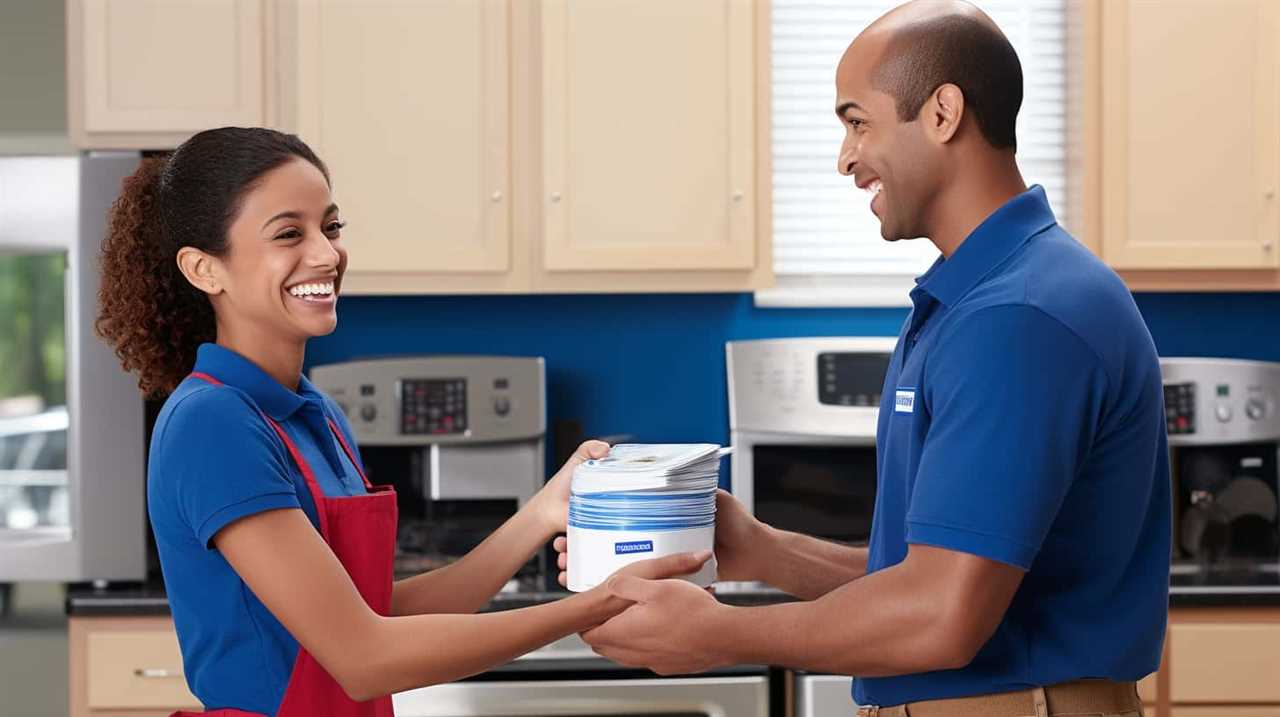
First, let’s discuss voltage compatibility, as it’s crucial to ensure that your appliance can handle the different electrical system in the UK.
Next, we’ll delve into the different types of appliance adapters available, which allow you to physically connect your US plug to a UK outlet.
Voltage Compatibility Explained
Our experience with voltage compatibility in the UK has shown that using adapters and converters on US appliances is essential for proper functionality.
Voltage compatibility limitations are a common issue when using US appliances in the UK.

The main difference between the two countries is the voltage supplied to households. In the US, the voltage is typically 120 volts, while in the UK, it’s 230 volts.
This difference can cause problems when using US appliances in the UK, as they’re designed to operate on a lower voltage. Adapters and converters are used to bridge this gap by converting the voltage from 230 volts to the appropriate voltage for the US appliances, ensuring that they receive the correct amount of power.
Troubleshooting voltage issues can be done by checking the voltage requirements of the appliances and using the appropriate adapters and converters.
Types of Appliance Adapters
We found that using the right adapters and converters is essential for using US appliances in the UK. In order to connect US appliances to UK power outlets, you’ll need plug adapters. These adapters allow you to physically plug in your US appliance into a UK power outlet.

However, it’s important to note that plug adapters only address the physical connection and don’t address the voltage difference between the US and UK. To ensure that your US appliances work properly in the UK, you’ll also need voltage converters. Voltage converters are designed to convert the UK’s higher voltage to the lower voltage required by US appliances. Without a voltage converter, your US appliances may not function correctly or may even get damaged.
Now let’s move on to discussing the difference between a converter and a transformer.
Converter Vs. Transformer
Moving from discussing the types of appliance adapters, let’s now delve into the comparison between converters and transformers for using US appliances in the UK.
When it comes to using US appliances in the UK, it’s important to consider the differences in voltage and power consumption between the two countries.

A converter is a device that changes the voltage of the electricity supply, allowing US appliances to work with the UK’s lower voltage.
On the other hand, a transformer is a device that converts the voltage while also regulating it, ensuring a consistent and safe power supply for the appliance.
While converters are cheaper and more readily available, transformers are often preferred for their ability to provide a more stable and regulated power supply, reducing the risk of damage to the appliance.
Dual Voltage Appliances
When traveling to the UK, it’s important to consider the compatibility of dual voltage appliances. These appliances are designed to operate on different voltage levels, making them suitable for use in both the US and the UK.

Here are three key points to understand about dual voltage appliances:
- Voltage Regulation: Dual voltage appliances have built-in voltage regulators that allow them to adjust to different power supply voltages. This ensures that the appliance receives the correct voltage and operates safely and efficiently.
- Power Consumption: It’s crucial to check the power consumption of your dual voltage appliance. The UK operates on a 230V power supply, while the US uses 120V. Make sure your appliance can handle the higher voltage to avoid damage or malfunction.
- Compatibility: While dual voltage appliances can be used in the UK, it’s important to check the plug type and ensure it’s compatible with UK outlets. Using a plug adapter or purchasing a UK-specific plug can help you connect your appliance safely.
Voltage Converters Vs. Transformers
When it comes to using US appliances in the UK, one important consideration is whether to use a voltage converter or a transformer.
Voltage converters are devices that can step up or step down the voltage to match the requirements of the appliance.
Transformers, on the other hand, are specifically designed to step down the voltage.

The choice between the two depends on the safety and compatibility of the appliance being used.
Converters Vs. Transformers
We prefer using voltage converters over transformers when using US appliances in the UK. Voltage converters are specifically designed to convert the electrical compatibility between different countries, allowing appliances to function properly without the risk of damage.
Here are three reasons why voltage converters are the better choice:
- Precision: Voltage converters have built-in voltage regulators that ensure a precise and stable output voltage, preventing any fluctuations that could harm sensitive electronic devices.
- Versatility: Voltage converters come in various wattage capacities, allowing you to choose the appropriate converter for your appliance’s power requirements. This flexibility ensures compatibility with a wide range of devices.
- Portability: Voltage converters are compact and lightweight, making them easy to carry and use while traveling. They’re also equipped with multiple outlets, allowing you to power multiple appliances simultaneously.
Safety and Compatibility
To ensure safety and compatibility when using US appliances in the UK, it is essential to consider the differences between voltage converters and transformers. Voltage safety and appliance compatibility are key factors to consider when using appliances from different countries.

A voltage converter is a device that changes the voltage of the electricity coming from the wall outlet to match the voltage requirements of the appliance. On the other hand, a transformer is a device that not only changes the voltage but also adapts the electrical current to match the appliance’s needs.
Here is a table comparing voltage converters and transformers:
| Feature | Voltage Converter | Transformer |
|---|---|---|
| Voltage Conversion | Yes | Yes |
| Current Adaptation | No | Yes |
| Suitable for All Appliances | No | Yes |
| Size | Compact | Bulky |
| Cost | Affordable | Expensive |
Safety Considerations
One important safety consideration when using US appliances in the UK is the voltage difference between the two countries. The US operates on a 120-volt system, while the UK uses a 230-volt system. This means that US appliances designed for 120 volts may not be able to handle the higher voltage in the UK.
To ensure safety and prevent damage to the appliances, it’s crucial to consider the following:

- Voltage regulations: The UK has strict regulations regarding electrical appliances to ensure safety. It’s important to check if the US appliance complies with these regulations before using it in the UK.
- Safety standards: US appliances may not meet the safety standards required in the UK. It’s essential to verify if the appliance has been tested and certified for use in the UK to avoid any potential hazards.
- Voltage converters or transformers: To safely use US appliances in the UK, voltage converters or transformers may be necessary to adjust the voltage to the appropriate level.
Considering these safety considerations will help prevent electrical accidents and ensure the proper functioning of US appliances in the UK.
Now let’s delve into the details of using US appliances in the UK.
Using US Appliances in the UK
Continuing from the previous subtopic on safety considerations, let’s now explore how we can use US appliances in the UK.
When using US appliances in Europe, one of the key challenges is the difference in voltage. In the US, appliances typically operate on 120 volts, while the UK operates on 230 volts. This difference in voltage can cause damage to the US appliances if they’re directly plugged into UK outlets.

To overcome this issue, voltage converters can be used. These converters help convert the higher UK voltage to the lower US voltage, allowing US appliances to function properly. It’s important to ensure that the voltage converter is compatible with the specific appliance and can handle the required wattage.
Common US Appliances and Their Compatibility
Let’s explore the compatibility of common US appliances in the UK. When using US appliances in the UK, it’s important to consider the differences in voltage and electrical standards. Here are three key points to keep in mind:
- Voltage Difference: The US operates on a 120V electrical system, while the UK uses 230V. This means that US appliances designed for 120V may not work properly in the UK without a voltage converter.
- Safety Precautions: It’s crucial to use voltage converters that are compatible with the specific appliance and meet safety regulations. Using an incorrect converter can lead to damage or even fire hazards.
- Plug Type: US appliances typically have two flat pins, while UK outlets require three rectangular prongs. Adapters can be used to convert the plug shape, allowing US appliances to be plugged into UK outlets.
When using US appliances in the UK, always prioritize safety and ensure proper compatibility with the electrical system.
Hair Styling Tools
When it comes to using hair styling tools from the US in the UK, voltage compatibility is a crucial factor to consider. US appliances typically operate on 110-120 volts, while UK outlets provide 220-240 volts.

This means that using a US hair styling tool in the UK without a voltage converter can cause damage to the tool or even pose a safety risk.
Additionally, it’s important to note that US and UK plugs and sockets have different designs, so an adapter may be necessary for compatibility.
Voltage Compatibility for Hair Tools
To ensure the safe and effective use of hair styling tools in the UK, it’s important to consider their voltage compatibility. When using hair tools from the US in the UK, there are certain safety considerations to keep in mind. Here are three key points to remember:
- Voltage Difference: The UK operates on a voltage of 230V, while the US typically uses 120V. Hair styling tools designed for the US market may not be compatible with the higher voltage in the UK.
- Power Adapters: To use US hair tools in the UK, you’ll need a power adapter or converter. This device will adjust the voltage to match the requirements of your hair tool, ensuring safe operation.
- Dual Voltage Tools: Some hair styling tools are designed to work with both US and UK voltages. These tools often have a switch or a dual voltage setting, allowing you to easily switch between different voltage requirements.
Plug and Socket Differences
Moving on to the plug and socket differences for hair styling tools, we found that adapting the US appliances to the UK power system requires more than just adjusting the voltage. In addition to the voltage converters, plug compatibility is another crucial aspect.

In the US, the standard plug and socket type is the Type A, which has two flat pins. On the other hand, the UK uses the Type G plug, which has three rectangular pins.
To use US hair styling tools in the UK, you’ll need to use a plug adapter that converts the Type A plug to the Type G socket. These plug adapters are readily available and can be purchased online or in stores. With the correct plug adapter, you can ensure that your US hair styling tools are compatible with the UK power system.
Now let’s move on to discussing travel-friendly hair appliances.
Travel-Friendly Hair Appliances
After discussing the plug and socket differences for hair styling tools, we can now explore travel-friendly hair appliances.
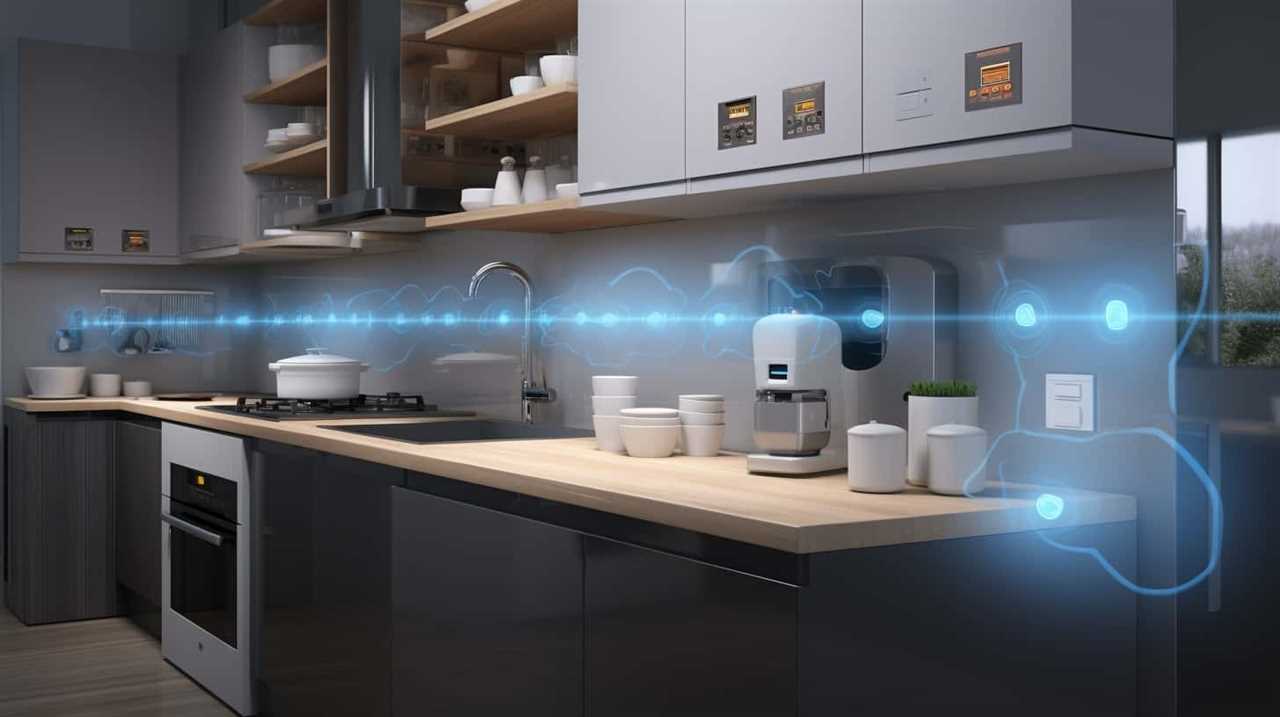
When it comes to travel, it’s important to have hair styling tools that are compact, lightweight, and compatible with different voltage and socket types. Here are some tips for buying travel-sized hair appliances:
- Consider dual voltage: Look for hair appliances that have dual voltage capabilities, allowing them to be used in both the US and the UK. This ensures that you can easily switch between different power outlets without the need for a voltage converter.
- Compact and lightweight: Opt for travel-friendly hair appliances that are compact and lightweight. This makes them easier to pack and carry in your luggage, without adding unnecessary bulk.
- Universal plug adapters: Invest in universal plug adapters that can be used in different countries. This way, you can simply attach the adapter to your travel-sized hair appliances and plug them into the sockets in the UK without any issues.
Now that we’ve covered travel-friendly hair appliances, let’s move on to discussing kitchen appliances.
Kitchen Appliances
Using US kitchen appliances in the UK can sometimes be a challenge. The main issue is the difference in voltage and plug types between the two countries. In the US, the standard voltage is 120V, while in the UK, it is 230V. This means that US appliances designed for 120V may not work properly in the UK without the use of voltage converters. Additionally, the plug types are different, with the US using Type A and B plugs, and the UK using Type G plugs. To help you understand the compatibility of US kitchen appliances in the UK, here is a table outlining the voltage and plug differences:
| US Kitchen Appliance | Voltage | Plug Type |
|---|---|---|
| Blender | 120V | Type A/B |
| Coffee Maker | 120V | Type A/B |
| Toaster | 120V | Type A/B |
| Microwave | 120V | Type A/B |
Before using any US kitchen appliances in the UK, make sure to check if they are compatible with the higher voltage and have the appropriate plug type to avoid any electrical mishaps.

Electronics and Entertainment Devices
Now let’s delve into the compatibility of electronics and entertainment devices when using US appliances in the UK. When it comes to electronics compatibility, there are a few key considerations to keep in mind:
- Voltage: In the UK, the standard voltage is 230 volts, while in the US it’s 120 volts. This means that US electronics, such as TVs, DVD players, and game consoles, may not work properly in the UK without a voltage converter.
- Power plugs: The UK uses a different type of power plug, known as the BS 1363 or Type G plug. US electronics will require an adapter to fit into UK power outlets.
- TV standards: The UK uses the PAL TV standard, while the US uses NTSC. This can affect the compatibility of US TVs and DVD players in the UK, as they may not be able to display or play content correctly.
When considering entertainment device compatibility, it’s essential to check the voltage, power plugs, and TV standards to ensure seamless usage in the UK.
Laundry Appliances
Continuing our exploration of appliance compatibility when using US appliances in the UK, let’s now turn our attention to laundry appliances.
When it comes to using US laundry appliances in the UK, voltage requirements play a crucial role in determining compatibility. In the United States, laundry appliances typically operate on a voltage of 120V, while in the UK, the standard voltage is 230V. This difference in voltage means that US laundry appliances may not function properly without the use of a voltage converter or transformer.

Additionally, it’s important to consider the plug type and shape, as US appliances often have different prongs and sockets compared to those used in the UK. To ensure appliance compatibility and prevent any potential damage, it’s recommended to consult the manufacturer’s specifications and guidelines.
Now, let’s move on to discussing the compatibility of medical devices.
Medical Devices
Let’s now shift our focus to the compatibility of medical devices when using US appliances in the UK. When it comes to importing medical devices, it’s essential to understand the medical device regulations in both countries. Here are three important points to consider:
- Regulatory Differences: The UK and the US have different regulations for medical devices. The Food and Drug Administration (FDA) oversees medical device regulation in the US, while the Medicines and Healthcare products Regulatory Agency (MHRA) is responsible for regulating medical devices in the UK. It’s crucial to adhere to the specific requirements and guidelines set by these regulatory bodies.
- Voltage and Power Compatibility: US appliances operate at 110-120 volts, while the UK uses 220-240 volts. It’s essential to check if the medical device can handle the voltage difference. If not, a voltage converter or transformer may be necessary to ensure compatibility.
- Plug and Socket Types: The US and the UK have different plug and socket types. US appliances use Type A or Type B plugs, while the UK uses Type G plugs. Adapters may be required to connect US medical devices to UK power outlets.
When importing medical devices, it’s crucial to comply with medical device regulations and consider voltage and plug compatibility to ensure the safe and effective use of these devices in the UK.
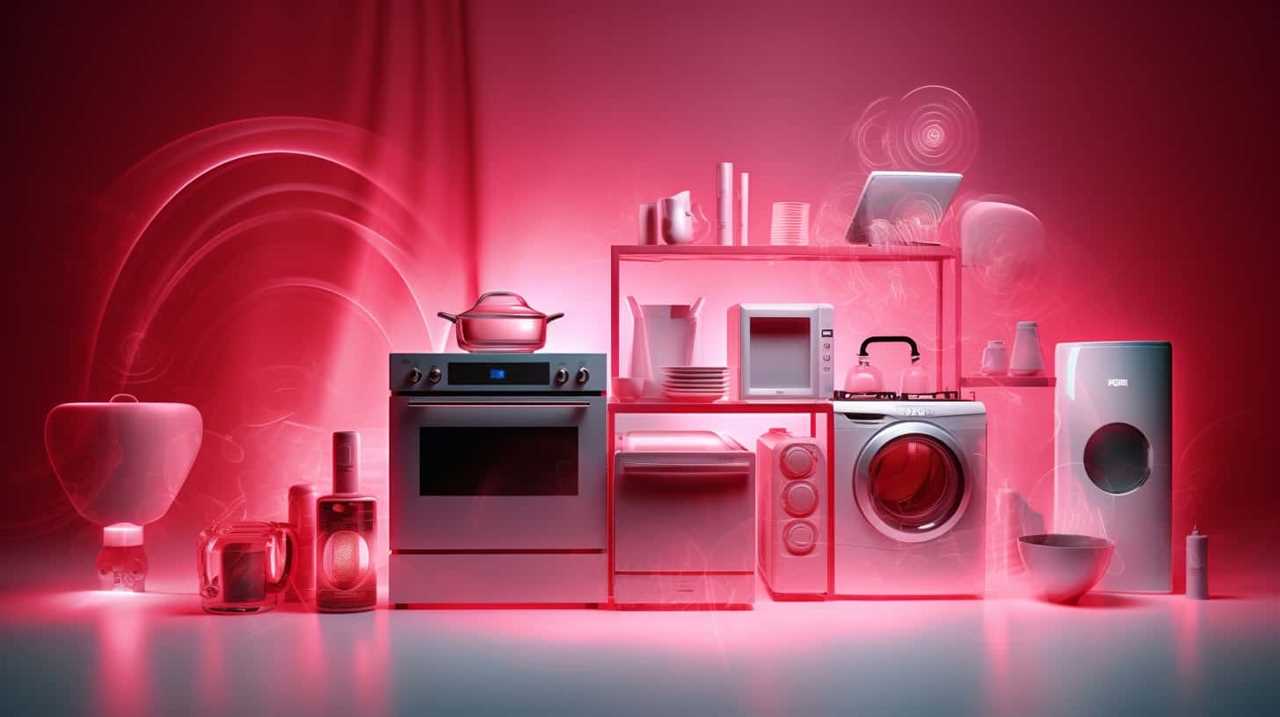
Traveling With US Appliances to the UK
When traveling with US appliances to the UK, one of the main concerns is voltage compatibility.
The United States uses a 120-volt electrical system, while the UK uses a 230-volt system.
This means that US appliances may not work properly without the use of an adapter or converter.
Voltage Compatibility Concerns
We need to consider the voltage compatibility when traveling with US appliances to the UK. The United States operates on a 120-volt electrical system, while the UK operates on a 230-volt electrical system. This difference in voltage can pose a problem when trying to use US appliances in the UK.

Here are three important points to consider:
- Voltage converters: To use US appliances in the UK, you’ll need a voltage converter. These devices convert the UK’s higher voltage to a level that’s suitable for US appliances. It’s important to choose a converter that can handle the wattage requirements of your appliances.
- Electrical safety: Using US appliances in the UK without a voltage converter can lead to electrical safety hazards. Plugging a 120-volt appliance into a 230-volt outlet can cause damage to the appliance and potentially start a fire. It’s crucial to prioritize electrical safety and make sure you have the appropriate voltage converter.
- Compatibility check: Before traveling, check the voltage requirements of your US appliances. Some appliances, such as laptops and smartphones, have built-in voltage converters and can be used with a simple plug adapter. However, appliances like hair dryers and coffee makers may require a separate voltage converter to work properly.
Adapter or Converter Required
To successfully use US appliances in the UK, we’ll need an adapter for the different plug shapes and a voltage converter to accommodate the higher voltage. In the UK, the standard voltage is 230 volts, while in the US it’s 120 volts. This difference in voltage can cause damage to appliances not designed for international compatibility.
An adapter is necessary to convert the US plug shape to the UK plug shape, allowing the appliance to be plugged into the UK power outlets. However, an adapter alone won’t be sufficient to protect the appliance from the higher voltage. A voltage converter is also required to ensure the appliance receives the correct voltage and operates safely.
It’s important to check the wattage and voltage requirements of your US appliances before traveling to the UK to ensure you have the appropriate adapter and voltage converter for a hassle-free experience.

Tips for Buying Appliances in the UK
Before purchasing appliances in the UK, it’s important to be aware of a few key tips.
- Check the Voltage: In the UK, the standard voltage is 230 volts, while in the US it’s 120 volts. Ensure that the appliance you’re buying is compatible with the UK voltage. If not, you’ll need to use a voltage converter to avoid damaging the appliance.
- Research Safety Standards: The UK has strict safety regulations for appliances. Look for appliances that comply with the British Standards Institution (BSI) or the European Union (EU) safety standards. This ensures that the appliance meets the necessary safety requirements and is safe to use.
- Consider Energy Efficiency: Energy efficiency is an important factor when buying appliances. Look for appliances with a high Energy Efficiency Rating (EER) or Energy Efficiency Class (EEC). This will help you save on energy bills and reduce your environmental impact.
Frequently Asked Questions
Are There Any Safety Considerations When USing US Appliances in the Uk?
When using US appliances in the UK, safety precautions must be taken into account. It is important to consider the difference in voltage between the two countries and use voltage converters to prevent damage or electrical hazards.
What Are the Common US Appliances and Their Compatibility in the Uk?
Yes, US appliances can be used in the UK with the right voltage compatibility. However, it’s important to check the voltage requirements of each appliance and use a voltage converter if necessary.
Can US Hair Styling Tools Be USed in the Uk?
Yes, hair styling tools from the US can be used in the UK. However, they may require a voltage converter due to the difference in electrical systems between the two countries.

Are US Kitchen Appliances Compatible With UK Electrical Systems?
When considering US kitchen appliances for use in the UK, it’s important to understand the voltage differences and their impact on performance. Adapters or converters may be necessary to ensure compatibility.
Can US Electronics and Entertainment Devices Be USed in the Uk?
Yes, US electronics can be used in the UK. However, it is important to consider their compatibility with the UK electrical system. When using US entertainment devices in the UK, make sure to use appropriate voltage converters or adapters to ensure proper functionality.
Conclusion
In conclusion, it’s important to consider voltage differences and plug types when using US appliances in the UK. Adapters and converters can help with compatibility, but it’s essential to check if appliances are dual voltage to avoid damage.
While voltage converters and transformers are options, they may not be necessary for all appliances. When traveling to the UK, it’s recommended to research and purchase appliances locally to ensure compatibility.

Remember, navigating these differences can be as challenging as wrestling with a thousand electric eels!


